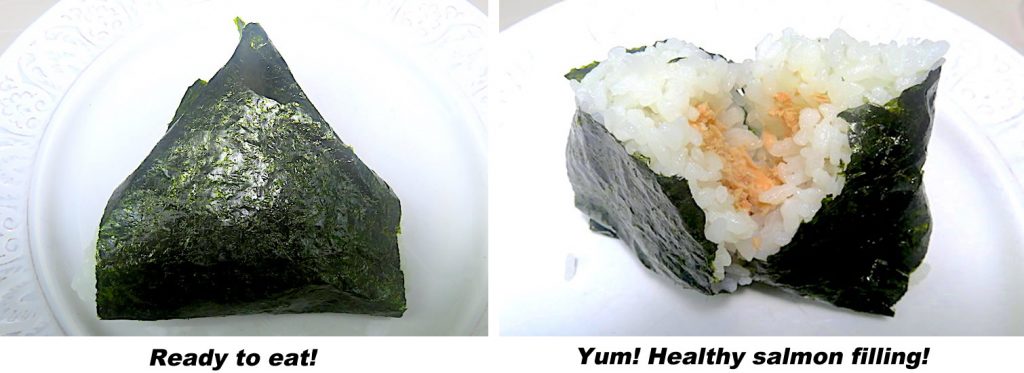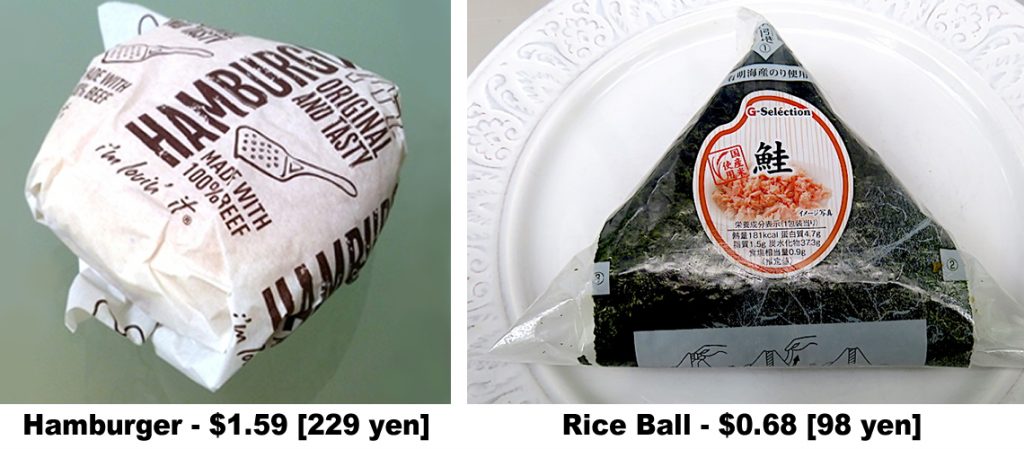When Americans needs to eat on the fly, they grab a hamburger.
When Japanese need to eat on the fly, they grab a rice ball.
The basic rice ball — actually there are no fancy rice balls — costs around 98 yen [$0.68].
Hamburgers can of course be upgraded with an enormous array of options. In an upscale restaurant, they can be over $18.00, in that case with the hamburger experience significantly enhanced by having it delivered to your table — the one with a view of the city skyline — by a lovely waitress or handsome waiter, smiling ear-to-ear. Even at McDonald’s, a Double Bacon Quarter Pounder with cheese sets you back $6.99 [1005 yen]. The most basic hamburger at McDonald’s — meat and bun, no cheese — pictured above, is $1.59 [229 yen], almost 2 1/2 times what a rice ball costs.
Then again, you get a lot in an American hamburger that you don’t get in a Japanese rice ball. There’s the preservatives, the growth hormones, the antibiotics, the residues of pesticides and herbicides, the traces of antipsychotics, blood pressure modulators, sleep aids, cocaine, MDMA and other recreational drugs commonly found in the drinking water in the U.S., micro-plastics, maybe depleted uranium.
Both being fast foods, hamburgers and rice balls come ready to eat. Theoretically, you can start chomping them down as soon as you pay for them, right at the check-out counter. For certain, you can eat them in your car or even walking to your car.
Unwrapping them is slightly different. I’ve had friends back in the U.S. who actually don’t even bother unwrapping a McDonald’s hamburger. They eat the wrapping right along with the burger and say it tastes pretty much the same, nice and greasy.
Unwrapping the rice ball is a little more involved. Masumi patiently instructed me in what she calls the 1-2-3 method and with some practice, I managed to master it. Here it is . . .
Now as long as this went according to plan, the delicious rice ball is ready for consumption!

Every culture has its advantages and disadvantages. I really love a good hamburger but I was never convinced that McDonald’s hamburgers were actual food. A long long time ago, when I was a pimply 20-something musician, I confess to being hooked on Big Macs. I recall they tasted really good, especially sitting in a park listening to some other local band.
Nutritional advice was not so readily available back then, at least not to the dumb-downed public, of which I was a clueless member. The most profound meme — this was before the word ‘meme’ had even been invented — on eating was: ‘You are what you eat.’ Which was among the reasons I never ate truck tires or dog poop.
Now, everything you wanted to know and a lot you don’t want to know is available on the web. There are no excuses for the eating habits — and yes, they are habits — of people and countries.
I’m not going to preach. I’ll close by making a couple points . . .
First, the most delicious rice ball doesn’t come close to tasting as good as the most delicious hamburger. That’s just a reality.
Here’s another reality, a statistical reality.
The life expectancy in the U.S. is 76.1 and falling. The life expectancy in Japan is 85.0 and rising.
Conclusion: Choose what you eat as if your life depended on it.

